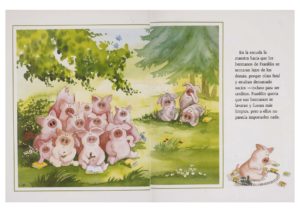
Easy, right?
Welcome to another blog entry on study methods for the Spanish language. Click on this link to read the last blog entry on the usefulness (or lack thereof?) of incorporating grammar into a study routine. This week we are going to be looking at…
Learning Spanish with Books for Children
There’s no doubt that reading advanced materials in another language can help an adult improve their second language. For most of us, this is a phase which comes towards the intermediate and advanced levels, when we are confident enough with the basics to be able to read such things as books, magazines and newspapers. There are even dual-text books with one language on one page, and the target language on the other (or vice versa). Many a student has told me about the book, magazine, website or other source that they’re currently reading. Every now and then, someone will tell me about the children’s book that they are using to help ease them into the language with something that would be…..well, pretty easy, right?
Nope.
The Problems with Learning this Way
Spanish is quite different from English, and advanced topics and vocabulary in English don’t equate to advanced topics and vocabulary in Spanish. Some of the simplest expressions in English such as “I want you to throw the ball” (quiero que lances la pelota) are phrased completely differently in Spanish. The literal translation is something along the lines of “I want that you might throw the ball”. A bit different, hey? The sentence “don’t give it to him” (no se lo des) is literally translated as “not to him it you give”, and even with that quite literal translation, it still doesn’t quite capture some of the other untranslatable nuances which would a) have most students asking what the hell was going on, and b) would require a few pages more of explanations. To learn the above sorts of things, you would need to have a solid understanding of advanced grammar, as well as a good couple of years of conversation practise under your belt. Yet these are the types of phrases that you will find in any number of children’s books in Spanish.
Children’s books in Spanish are simply not written for adults learning a second language
Things which are alien, and therefore quite advanced for the English speaker, are engrained into the mind of a Spanish-speaking child quite early on, without much thought going into the grammar, and this is indeed the way we learn English as children as well. Yet as adults, it is significantly more difficult to learn this way. See this post on grammar for an in-depth explanation as to why.
As you can see, just because the story is about a large red dog who gives piggy back rides to a group of mischievous kittens, or a little mouse witch who practises good magic and grants wishes to well behaved little rabbits, this won’t necessarily translate into you picking up Spanish. Simple content does not necessarily equal simple language acquisition.
Are English and Spanish Complete Strangers?
So the sentence structure differs somewhat between both languages, owing to the fact that one is a romance language and the other a Germanic. Yet this doesn’t mean that Spanish and English are complete strangers. There are an enormous number of words which are the same in English and Spanish. A cognate is a word which has the same meaning in two languages, and owing to a common ancestry, has similar or identical spelling. Spanish and English share plenty (thousands, even) of these, due to both languages’ combined connection with Latin and Greek, as well as the English connection with French. Words like animal, restaurant, information, essential and technological (among countless others) are the same in both English and Spanish. These are the sorts of words you will be likely to acquire when reading Spanish, yet they are the things which are lacking in a lot of children’s books, because cognates with a Latin or Greek root tend to be slightly (or a lot) more technical.
What are the Best Texts for Beginners?
If you are happy to simply acquire random words for the sake of random words, then you may as well continue reading children’s books. It’s not like you’re not going to learn anything. There’s nothing wrong with this in essence, and any learning is better than no learning.
I think that the best choice would be to go with something that is written with English speakers in mind. These sorts of texts, found in language learning books and websites, tend to be written by experts in the field, and they are generally written as learning resources which utilise the basic structures which are first taught to the English speaker in a Spanish class, with grammar in mind. Moreover, they will likely make liberal use of cognates, which should lead to a rapid acquisition of new vocabulary due to their familiarity.
Given all of this, the last option should come as no surprise. A great couple of resources for learning a second language would undoubtedly have to be newspapers and magazines. These are littered with words derived from Greek, Latin, and French, many of which you will undoubtedly recognise. Now these texts may or may not be tough going, depending on how complicated the article is, or how advanced your Spanish is, but in spite of not understanding a little (or a lot), you will probably learn much more from reading an article about the war in Syria, or a new technological breakthrough, than you will from reading about Frederick the dinosaur and his Easter egg hunt on his uncle’s farm – exciting as that may sound.
Share this article!
